
Church Tackles Mr. Walleye
Planer Board

Click
here for more info or to order on-line













Promotional
Team Favorites
Lodging food and more





 Mark Martins
Mark Martins
Lake
Superior Beachfront home for rent


|
Fishing the Great Lakes in April
by Mark Martin
Before the walleye season starts on most inland waters, the options
are anything but in abundance. But the abundance of the only option‹the
only game in town‹is one of sheer plenitude. We're talking about the Great
Lakes, from Michigan to Erie and beyond, where the waters around the river
mouths are with few exceptions open year-round.
Which is why there's no time like the present to hit the couple of miles
around the rivers and the reefs and adjacent depths where walleyes congregate
in April. When covering water is at a premium and baitfish are in Great
Lakes abundance‹which is the rule, not the exception‹trolling is the ticket
not only to put a bait in front of more predators but to stand out from
the crowd of smelt, alewives and gizzard shad. This is where the big ones
live, often suspended over open water, feeding both day and night. For
numbers, there¹s always the opportunity to hit the reefs with jigs
and mop up on smaller males. Seems to me the options are surprisingly varied
for time when, for all intents and purposes, nothing else is doing. Well,
then again, not in my books
Daytime Doings
In my early years, fishing with my grandfather and father around the
Muskegon Lake river mouth, in Michigan, we caught monster walleyes trolling
near the beach and around the pier heads. The pattern still holds true,
but since then I've found even greater numbers within a two-mile radius
of the river mouth. So it is from the Muskegon to Erie's Maumee.
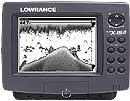 Lowrance
Lowrance
X-15
|
During the day, I start looking with electronics for bait and trolling
for suspended fish that may be down 10 to 25 feet. Most of the time you'll
see the bait, but unless the walleyes are highly concentrated, you'll seldom
see
fish. Still, I put my lines out so my crankbaits are running atop the
schools of bait, since predators such as walleyes tend to look up, not
down, when pursuing prey. When I spot a blob of bait on my Lowrance’s
X-15 unit, which also has GPS capabilities, I punch in a waypoint or
an icon for future reference. |
As I'm trolling I'll often identify four or five key schools of bait and
then troll between them. Sometimes only one or two of the schools are holding
walleyes. You have to cover water to find out.
Speed control and the proper lures are key to connecting. I troll with
my Mercury 9.9-horsepower four-stroke kicker, which will push my big Lund
2025 at a slow crawl. My favorite speed during the daytime is about 1.5
mph. At
this pace, I get solid action out of Rapala
Down Deep Husky Jerks, slim minnow baits that achieve excellent depth
and have a light wobble that triggers fish in cold water. If I can't get
the suspended fish going, or if I mark some big arcs near bottom, I'll
switch over to leadcore to get the cranks within a foot or two of bottom.
But you have to watch the locator and
pay close attention to the depth |
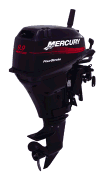
Mercury
9.9 h.p |
The beauty of leadcore is that if the bottom rises, you simply speed up
and the line lifts above the hump or ledge. When you get past it, count
to 30 and then slow down. Leadcore will sink back into the walleye's range.
On Erie, principles stay the same with bait and speed control, but I'll
often troll the edges of reefs where the big females suspend. Planer
boards
are incredibly important to spread lines to the side, where fish scoot
out
when the boat goes over them. The walleyes simply move right into the
path
of the lures.
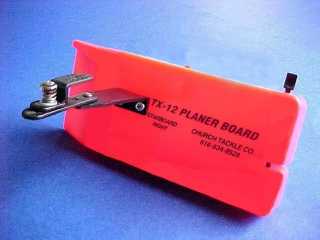 Church Tackles
Church Tackles
TX-12 Planer Board
|
For running small cranks, check out Church
Tackles new TX-6, about the size of a deck of playing cards. Boost
up to the more sizable
TX-12's with deeper, harder-diving crankbaits. In serious wind, the
TX-24,
with its accompanying ballast, rides the waves no problem. In the popular
areas of Erie off Niagara Reef or the Besse Davis Power Plant, I find most
fish in the top 15 feet of the water column over 30-plus feet of water,
which I reach with less than 50 feet of line behind the Church
boards. |
Sometimes it's best to go especially slow, right around 1.0 mph. Such
was the case when I took third in the 1999 In-Fisherman Professional Walleye
Trail event out of Port Clinton. And while April's cold waters might
be a
little early for a crankbait with more wobble such as the Rapala Tail
Dancer, the new balsa lures provide more a touch more side-to-side
movement
to set your offering apart from the hordes of baitfish. |
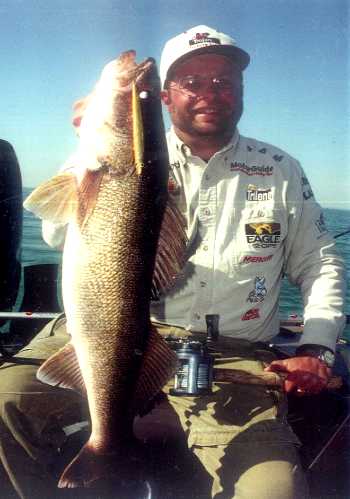 |
While the pinnacles of the reefs aren t the place to be for big fish, they're
the deal for hordes of males that congregate there, waiting for the hens
to move in. Again, keep an eye on your electronics, and when you see fish,
get a jig down into them.
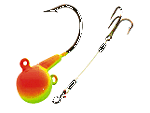
Northland
Fire-Ball. Jig |
Almost anything goes if it's a leadhead with a minnow, but I side with
Northland Fire-Balls or Whistler jigs, with their propellers, for added
flash and hum. A little trick around a lot of small, aggressive walleyes
is to put two minnows on the hook‹the first one right side up, the second
one upside down |
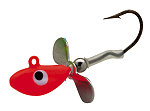
Northland
Whistler Jig |
This way, if one walleye filches your minnow, there¹s another
on the hook in case the same fish comes back or another one moves in. The
best depths I've found are from eight to 15 feet. |
After Hours
At night, the waters come alive with even more monsters, which feed
under
the cover of darkness. The same trolling techniques are the way to
go, the
prime technique to move from one baitfish pod to another, but it's
important
to make some adjustments. The reason: The fish do, too.
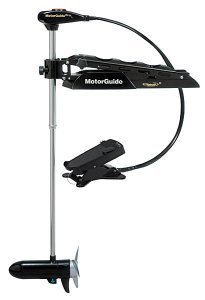
MotorGuide
Tour Edition |
In darkness, walleyes tend to move higher in the water column, up into
the top 10 feet. Now is the time to switch from the gas kicker to a powerful
trolling motor that has quality batteries and will ease along at 1.0 mph.
My Motor
Guide 107-pound thrust bowmount saps little juice from dependable Trojan
batteries. Now I can troll all night long with plenty of power. When I
have tried trolling with the gas motor, I've caught fish the first few
passes and had them turn off because of the noise. With the electric, I
keep
catching them. To work up higher toward the surface, I switch
to No. 13 Original Rapalas on 20-pound Berkley FireLine. Three No. 7 split
shots a few feet above it will get you down to 12 or 13 feet with 120 feet
of line out. Remove a split shot or let out less line to move higher |
I very seldom use planer boards at night, but if you must, keep small
boards close to the boat, just beyond
your other rods, to prevent congestion and bottlenecks with other trollers.
Another reason to go without boards is the ability to pump the Rapala forward
and drop it back‹a key trigger. |
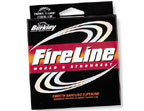 |
Slowly ease he rod forward about 18 inches and drop it back on a tight
line. I do this about 20 or 30 times a minute. Keep it gentle, otherwise
you'll pull the lure away from too many walleyes, which miss when the bait
has too much erratic action.
April is indeed a month of feast or famine. While it's feast on the
big
water, where seasons are open and walleyes prowling and nailing crankbaits,
it¹s famine on inland systems where most species are out of season.
In other
words, everything¹s doing on the Great Lakes. Now is the time
to make your
move.

Fish
Clix Banner Exchange
Walleyes Inc. website is maintained
by Randy
Tyler Fishing the In-Fisherman Professional Walleye Circuit, Masters
Walleye Circuit and the Team Walleye Circuit. All rights reserved.Copyright
1999/2002
Please visit these site sponsors
Daiichi/Tru-Turn Hooks,
Lindy
Little Joe,
R-A.M Mounting Systems,
Ranger
boats, Mercury Outboards,
Bedford
Sales , Church Tackle, Panther
Marine Products,
Webfoots body
sock, Bait Rigs Tackle ,Dual
Pro Charging Systems, Daiwa Rods and
Reels, Driftcontrol Wind socks
|


 Mark Martins
Mark Martins







